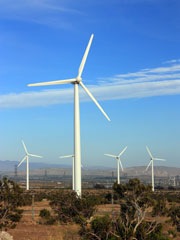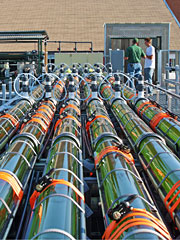July 29, 2011
Q&A with Eric Williams

Dr. Eric Williams


Solar panel, wind turbine, and biofuel technologies must all meet cost and efficiency goals if they are to solve critical sustainability challenges.
Eric Williams is a Senior Sustainability Scientist in the Global Institute of Sustainability and an assistant professor in both the School of Sustainability and the School of Sustainable Engineering and the Built Environment, Ira A. Fulton Schools of Engineering. He is best known for his work in life-cycle assessment, particularly the environmental impacts of recycled computer hardware. He also investigates energy topics such as the effects of development and urbanization on energy demand and forecasting technological change and growth. Dr. Williams teaches courses covering industrial ecology, design for sustainability, and sustainable consumption.
At what point did “sustainability” become part of your research vocabulary?
When I started my career as a mathematical physicist, I had never heard of the word “sustainability.” It didn’t become a part of my research focus until I made a career change, going to work for the United Nations University in Japan in their Environment and Sustainable Development Programme.
What is your most important sustainability-related research project right now?
I am working on a project that will allow us to better understand the potential for progress in emerging energy technologies such as photovoltaics, wind power, and biofuels. The world looks to these technologies to solve critical sustainability challenges, and substantial sums of public funds have been invested to improve and adopt these new energy technologies. Their development, however, is not where we need them to be in terms of their cost or impacts. More important, we still don’t understand their real potential to achieve future cost savings and also meet sustainability goals.
My project will forecast how these different technological paths can be expected to move toward their goals in coming years. It combines thermodynamic analysis of long-term efficiency limits with empirical models of historical progress. Using this technique, we can see, for example, that solar cells made from silicon wafers will require significantly increased investment to move from their current cost of $3 per watt to their target of $1 per watt.
How will your research affect policy or other decisions?
My work will provide the data that identifies which technologies are more likely to reach long-term goals. This will inform the government and private decision-makers who finance energy technology development and adoption.
What is the world sustainability challenge that concerns you most?
Energy. Nothing works without it, not even the solutions we devise for other sustainability issues. While improving technology is an important component of sustainability, it cannot be considered in isolation because as we develop more efficient technology it tends to drive greater adoption – and that creates impacts. To address this concern, we need to better understand the links between technology, growth, and adoption and then manage our systems to reduce negative effects.
July 29, 2011

